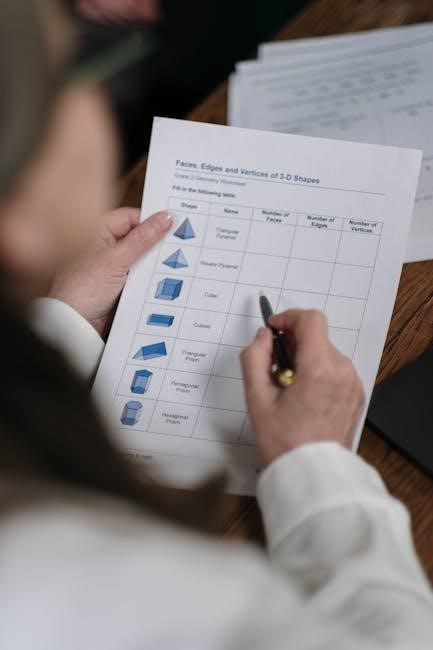Similar figures are shapes with the same shape but different sizes․ They help students understand proportional relationships, solve geometry problems, and apply mathematical concepts in real-world scenarios․
What Are Similar Figures?
Similar figures are shapes that have the same shape but different sizes․ They are characterized by equal corresponding angles and sides that are proportional․ A scale factor determines the ratio of their sizes․ These figures can be transformed into one another through resizing, flipping, or rotating․ Similar figures are fundamental in geometry for solving problems involving proportions, scale models, and real-world applications like architecture and map scales․ They help students understand how shapes maintain their properties despite differences in size․
Importance of Understanding Similar Figures
Understanding similar figures is crucial for developing proportional reasoning and problem-solving skills․ They help students grasp how shapes maintain their properties despite size differences, essential for geometry and real-world applications․ Similar figures are used in architecture, model building, and map scales, demonstrating their practical relevance․ Mastery of these concepts enhances spatial reasoning and prepares students for advanced math topics․ Worksheets on similar figures provide hands-on practice, ensuring a solid foundation in proportional relationships and scale factors․

Benefits of Using Similar Figures Worksheets
Similar figures worksheets enhance proportional reasoning, improve geometry skills, and strengthen problem-solving abilities․ They provide unlimited practice, customizable examples, and clear solutions for better understanding and retention of key concepts․
Developing Proportional Reasoning Skills
Proportional reasoning is fundamental in understanding similar figures․ Worksheets provide numerous exercises to help students grasp how ratios and proportions apply to shape sizes; By solving problems, learners develop the ability to identify scale factors and apply them across different scenarios․ This skill is crucial for advanced geometry and real-world applications like architecture and map scales․ Regular practice on worksheets ensures a solid understanding and fluency in proportional reasoning, preparing students for complex mathematical challenges․
Enhancing Geometry Knowledge
Similar figures worksheets play a vital role in enhancing geometry knowledge by introducing foundational concepts like proportional relationships, corresponding angles, and scale factors․ These exercises help students recognize how shapes maintain their form while differing in size, fostering a deeper understanding of geometric principles․ By practicing with various similar figures, learners improve their ability to identify and work with corresponding sides and angles, as well as calculate scale ratios․ This skill set is essential for tackling more complex geometry problems and real-world applications․
Improving Problem-Solving Abilities
Similar figures worksheets enhance problem-solving skills by requiring students to apply proportional reasoning and spatial awareness․ Solving for missing sides, calculating scale factors, and identifying corresponding angles and sides helps students develop logical thinking․ These exercises encourage critical analysis and strategic planning, preparing learners for more complex geometry challenges․ By practicing with diverse similar figures, students build confidence in tackling mathematical problems methodically and efficiently․
How to Solve Similar Figures Problems
Solving similar figures problems involves identifying corresponding sides and angles, setting up proportions, and calculating scale factors․ These steps help determine missing measurements accurately and efficiently․
Using Proportions to Find Missing Sides
Proportions are essential for finding missing sides in similar figures․ By identifying corresponding sides and setting up ratios, students can solve for unknown lengths․ For example, if two figures are similar with a scale factor of 3:5, each side of the smaller figure is multiplied by 5/3 to find the corresponding side in the larger figure․ This method ensures accuracy and reinforces proportional reasoning skills․ Regular practice with worksheets helps students master this critical geometry concept and apply it to various problems․

Understanding Scale Factors
Scale factors are ratios comparing corresponding sides of similar figures․ They determine how much one figure is enlarged or reduced relative to another․ A scale factor greater than 1 enlarges the figure, while a factor less than 1 reduces it․ For example, a scale factor of 2:5 means each side of the smaller figure is multiplied by 2․5 to find the corresponding side in the larger figure․ Understanding scale factors is crucial for solving problems involving similarity and proportions in geometry․
Applying Similarity in Real-World Scenarios
Similar figures are essential in real-world applications, such as architecture, where scale models are used to design buildings․ Maps rely on similarity to represent large areas on a smaller scale, helping navigate distances․ For instance, a map scale of 3 cm to 120 km allows users to measure distances accurately․ Additionally, similarity is used in creating scale models, like dollhouse furniture or a GI Joe figure representing a real person․ These practical uses highlight how similarity concepts, explored in worksheets, can solve everyday problems and design challenges effectively․

Key Concepts in Similar Figures Worksheets
Similar figures involve understanding corresponding angles, sides, and scale factors․ These concepts help students master proportional relationships and apply them to solve geometric problems accurately․
Corresponding Angles and Sides
In similar figures, corresponding angles are equal, and corresponding sides are proportional․ These relationships are fundamental for identifying similarity․ Worksheets often focus on matching angles and sides, ensuring students understand how scale factors influence side lengths․ By practicing with various shapes, learners develop the ability to identify and apply these correspondences to solve problems․ This concept is crucial for real-world applications, such as scale models and maps, where proportional relationships are essential․
Differentiating Between Similar and Congruent Figures
Congruent figures are identical in shape and size, while similar figures have the same shape but different sizes․ Worksheets emphasize understanding this distinction, as corresponding angles in both are equal, but sides differ proportionally in similar figures․ Congruent figures have equal corresponding sides and angles․ Recognizing these differences is crucial for solving geometry problems and applying concepts in real-world scenarios, such as scale models or maps․ Practice exercises help students master this fundamental distinction․
Calculating Scale Ratios
Scale ratios compare corresponding sides of similar figures, expressed as a fraction․ To calculate, identify corresponding sides, measure their lengths, and form a ratio․ For example, if one side is 4 cm and the corresponding side is 8 cm, the scale ratio is 4:8 or 1:2․ This ratio remains consistent for all corresponding sides․ Worksheets often include exercises where students practice finding scale ratios using proportions, ensuring they understand how sizes relate in similar figures․ This skill is essential for solving real-world problems involving scale models or maps․

Practical Applications of Similar Figures
Similar figures are used in architecture, model building, and real-world problem-solving․ They help scale designs, create maps, and solve proportion-related challenges in art and engineering projects effectively․
Architecture and Model Building
Similar figures play a crucial role in architecture and model building by enabling proportional scaling of designs․ Architects use scale models to visualize buildings, ensuring all elements maintain their proportions․ This concept allows for resizing structures without distorting their shape, making it essential for creating accurate miniatures and large-scale constructions․ By understanding similarity, professionals can transfer designs between different scales efficiently, ensuring consistency and precision in their work․ This application bridges theoretical geometry with real-world construction, showcasing the practical value of similar figures in creative and technical fields․
Map Scales and Geography
Similar figures are essential in map scales, where proportional relationships represent real-world distances․ Maps use scale ratios to maintain accuracy, ensuring smaller representations reflect actual landscapes․ This concept helps geographers and travelers understand distances and spatial relationships․ By applying similarity principles, maps can be scaled down without losing essential details, making them invaluable tools for navigation, resource allocation, and environmental planning․ This practical application of similar figures bridges geometry with real-world geography, emphasizing proportionality in mapping systems․
Art and Design
Similar figures play a crucial role in art and design, enabling creators to maintain proportional relationships while scaling images or objects․ Artists use similarity to resize compositions without distorting shapes, ensuring visual balance and harmony․ This concept is vital in graphic design, architecture, and crafting scale models․ By understanding similar figures, designers can create consistent and aesthetically pleasing works, whether resizing logos, designing patterns, or producing miniature prototypes․ This skill enhances creativity and precision, making it a cornerstone of artistic and design processes․
Creating Custom Similar Figures Worksheets
Educators can easily create custom similar figures worksheets using PDF generators and variable customization tools, ensuring endless practice opportunities for proportional reasoning and geometry skills development․
Using PDF Generators for Worksheets

PDF generators are powerful tools for creating custom similar figures worksheets․ They allow educators to generate an endless supply of unique worksheets by selecting specific variables or problem types․ These tools support customization, enabling teachers to adjust difficulty levels, include visual aids, and focus on particular skills like proportional reasoning․ PDF generators also save time by automating the worksheet creation process, ensuring professional-quality output․ This makes them an ideal resource for both classroom and home-based learning environments, catering to diverse educational needs effectively while maintaining engagement and challenge for students;
Designing Worksheets with Varying Difficulty Levels
Designing similar figures worksheets with varying difficulty levels ensures that students of all skill levels can engage effectively․ Start with basic problems for beginners, such as identifying corresponding sides and angles, then progress to more complex tasks like calculating scale ratios or solving proportions․ Incorporate visual aids like diagrams and real-world examples to make concepts clearer․ Advanced worksheets can include multi-step problems or applications in architecture and map scales․ This approach keeps the learning process challenging and tailored to individual progress, fostering a deeper understanding of similarity in geometry․ Worksheets can also be randomized to avoid repetition and maintain student engagement․
Including Visual Aids for Better Understanding
Incorporating visual aids into similar figures worksheets enhances comprehension by making abstract concepts more tangible․ Diagrams, scale models, and charts help students visualize proportional relationships and corresponding angles/sides․ Real-world examples, such as maps or architectural plans, illustrate practical applications․ These tools cater to different learning styles, ensuring that both visual and kinesthetic learners grasp the material effectively․ By combining textual explanations with imagery, worksheets become more engaging and accessible, fostering a deeper understanding of similarity principles and their real-world relevance․

Engaging Students with Interactive Worksheets
Interactive worksheets captivate students with features like drag-and-drop shapes, clickable proportions, and real-time feedback․ These tools make learning dynamic, keeping students focused and simplifying complex geometry concepts through hands-on exploration and collaboration․
Incorporating Real-World Examples
Real-world examples make learning about similar figures engaging and relatable․ Students can explore how architects use scale models to design buildings or how maps represent large areas in smaller scales․ These practical applications help students understand the relevance of similar figures in solving real-life problems, such as calculating distances or resizing objects proportionally․ By connecting abstract concepts to everyday scenarios, worksheets become more impactful and meaningful, fostering a deeper understanding of proportional relationships and their practical uses․
Using Technology to Enhance Learning
Technology enhances learning by providing interactive tools for exploring similar figures․ Online platforms offer customizable worksheets, such as those from Kuta Software, allowing students to practice with varied examples․ Digital tools enable real-time feedback, while 3D modeling software helps visualize proportional relationships․ Additionally, resources like ChatGPT can assist with problem-solving strategies, making complex concepts more accessible․ These tools cater to different learning styles, ensuring a comprehensive understanding of similar figures and their applications․
Encouraging Peer Collaboration
Peer collaboration fosters a supportive learning environment where students can explore similar figures together․ By working in pairs or small groups, students can share ideas, discuss problem-solving strategies, and learn from one another’s strengths․ Activities like pair-sharing worksheets or group projects encourage teamwork and communication․ Teachers can facilitate this by assigning collaborative tasks that require students to explain their reasoning․ This approach not only enhances understanding but also builds confidence and interpersonal skills, making the learning process more engaging and effective for everyone involved․
